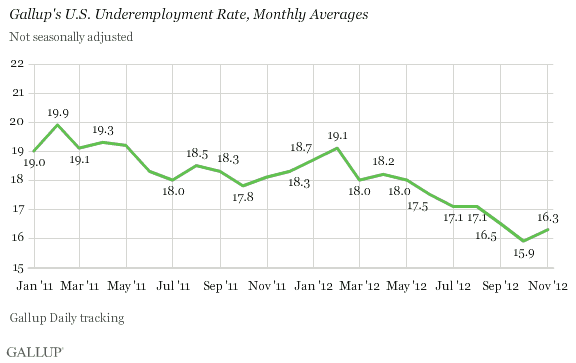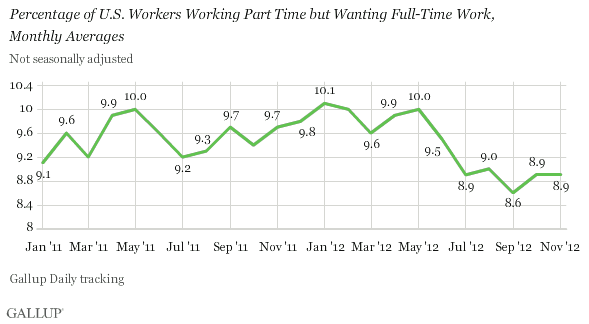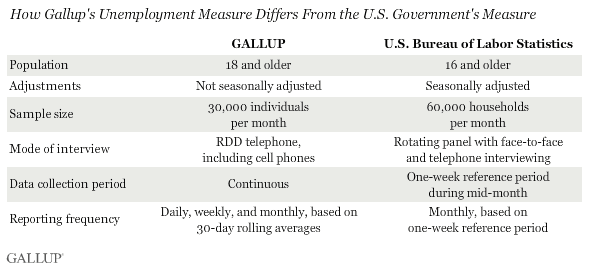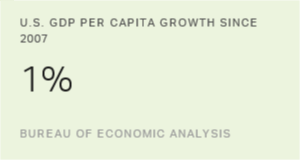WASHINGTON, D.C. -- U.S. unemployment, as measured by Gallup without seasonal adjustment, is 7.4% in mid-November, up from 7.0% in October but below the 7.9% of September. Seasonally adjusted unemployment is 7.9%, up from 7.4% in October but slightly lower than September's 8.1%.

These results are based on Gallup Daily tracking interviews, conducted by landline and cellphone with approximately 30,000 Americans from Oct. 14-Nov. 15 -- 68.2% of whom are active in the workforce. Gallup calculates the seasonally adjusted unemployment rate by applying the adjustment factor the government used for the same month in the previous year -- in this case, +0.5 percentage points in November 2011. Gallup's rolling 30-day periods of reference differ significantly from the reference period of the government's monthly reports, which is one week in the first half of the month.
Gallup's U.S. underemployment measure combines the percentage of workers who are unemployed in the workforce with the percentage of those working part time but looking for full-time work. Underemployment, as measured without seasonal adjustment, is 16.3% in mid-November, up from 15.9% in October and not much different from September's 16.5% rate.

The increase in the mid-November 30-day underemployment rate was driven by the increase in its unemployment component; the number of part-timers wanting full-time work was unchanged at 8.9% in mid-November, and was up slightly from 8.6% in September.

Implications
Gallup's unemployment results for the 30 days ending on Nov. 15 suggest that the improvement in the U.S. unemployment situation found in October was short-lived. Still, on an unadjusted basis, Gallup's unemployment and underemployment measures over the past two months show what might be expected holiday seasonal improvement. U.S. companies increase hiring for the Christmas holidays at this time of year.
At the same time, superstorm Sandy distorted weekly jobless claims, according to the U.S. Bureau of Labor Statistics, and may be doing the same to Gallup's unemployment results. The presidential election may also have disrupted the job market for a few days in early November.
Taking seasonal factors into account, it appears that the unemployment rate has remained around 8.0% since May. This seems consistent with other general economic data showing the economy growing slowly, the most recent of these being the 0.3% decline in October retail sales.
Looking ahead, Gallup's mid-November unemployment data have generally provided predictive insight into the official BLS numbers. In turn, Gallup's results suggest that in early December, the BLS could report an unchanged seasonally adjusted unemployment rate for November.

Gallup.com reports results from these indexes in daily, weekly, and monthly averages and in Gallup.com stories. Complete trend data are always available to view and export in the following charts:
Daily: Employment, Economic Confidence, Job Creation, Consumer Spending
Weekly: Employment, Economic Confidence, Job Creation, Consumer Spending
Read more about Gallup's economic measures.
View our economic release schedule.
Survey Methods
Results are based on telephone interviews conducted as part of Gallup Daily tracking from Oct. 14-Nov. 15, 2012, with a random sample of approximately 30,000 adults, aged 18 and older, living in all 50 U.S. states and the District of Columbia, selected using random-digit-dial sampling.
For results based on the total sample of national adults, one can say with 95% confidence that the maximum margin of sampling error is ±1 percentage point.
Interviews are conducted with respondents on landline telephones and cellular phones, with interviews conducted in Spanish for respondents who are primarily Spanish-speaking. Each sample includes a minimum quota of 400 cellphone respondents and 600 landline respondents per 1,000 national adults, with additional minimum quotas among landline respondents by region. Landline telephone numbers are chosen at random among listed telephone numbers. Cellphone numbers are selected using random-digit-dial methods. Landline respondents are chosen at random within each household on the basis of which member had the most recent birthday.
Samples are weighted by gender, age, race, Hispanic ethnicity, education, region, adults in the household, and phone status (cellphone only/landline only/both, cellphone mostly, and having an unlisted landline number). Demographic weighting targets are based on the March 2011 Current Population Survey figures for the aged 18 and older non-institutionalized population living in U.S. telephone households. All reported margins of sampling error include the computed design effects for weighting and sample design.
In addition to sampling error, question wording and practical difficulties in conducting surveys can introduce error or bias into the findings of public opinion polls.
For more details on Gallup's polling methodology, visit www.gallup.com.
